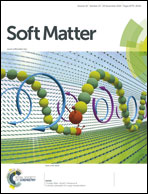Polymer fluctuation lubrication in hydrogel gemini interfaces
Abstract
Interfacial sliding speed and contact pressure between the sub-units of particulate soft matter assemblies can vary dramatically across systems and with dynamic conditions. By extension, frictional interactions between particles may play a key role in their assembly, global configuration, collective motion, and bulk material properties. For example, in tightly packed assemblies of microgels – colloidal microspheres made of hydrogel – particle stiffness controls the fragility of the glassy state formed by the particles. The interplay between particle stiffness and shear stress is likely mediated by particle–particle normal forces, highlighting the potential role of hydrogel–hydrogel friction. Here we study friction at a twinned “Gemini” interface between hydrogels. We construct a lubrication curve that spans four orders of magnitude in sliding speed, and find qualitatively different behaviour from traditional lubrication of engineering material surfaces; fundamentally different types of lubrication occur at the hydrogel Gemini interface. We also explore the role played by polymer solubility and hydrogel–hydrogel adhesion in hydrogel friction. We find that polymer network elasticity, mesh size, and single-chain relaxation times can describe friction at the gel–gel interface, including a transition between lubrication regimes with varying sliding speed.


 Please wait while we load your content...
Please wait while we load your content...